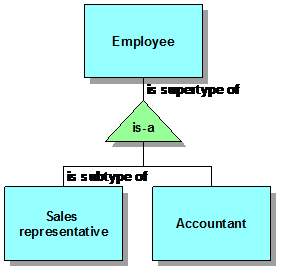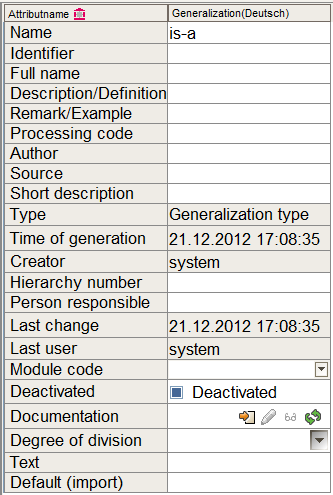Generalization/specialization - aka “is-a relationship” – is typically used to represent hierarchical associations between entity types. The subordinated (“specialized”) entity type is a subset of the superior (“generalized“) entity type; it inherits the attributes and relationship types of the “generalized“ entity type. A specialized entity type, however, may have attributes and relationship types of its own.

Figure 1: Generalization/specialization relationship type
In ARIS the object type “Generalization type” and the connection types “is supertype of” and “is subtype of” are necessary to model generalization/specialization relationships.
“Generalization type” is a typical ARIS object type. Thus, it has attributes (see Figure 2). In the above example the object is named “is-a”. Many customers use this name or even leave it out. But, if you want to give the object a meaningful name, I suggest to specify the differentiation criterion. In the above example you could for example use “employee role”.

Figure 2: Attributes of the object type “Generalization type”
The attribute “Degree of division” allows you to specify whether the specialization is complete (or not) and disjoint (or not). This attribute is a value attribute. The predefined values are shown in Figure 3. They are explained at a later date in the article on cardinalities.

Figure 3: Values of attribute “Degree of division”
In my opinion, there is a mistake. Do you see it? If so, tell it to the ARIS Community. Otherwise, wait until my article on cardinalities is available.
Additional object types in the eERM
In the eERM in ARIS you can find additional object types: application system type, IT function type, capability, service type, and socket. These object types do not belong to the ARIS data view, but to the ARIS function view. They have been introduced in the eERM based on the strong demand of an important ARIS customer. However, I suggest not to use these object types in the eERM and to deactivate them in a filter.
The same holds for the object type “COT attribute”, which is also available in the ARIS eERM. “COT” is the abbreviation for “Complex object type”. The COT attribute was used in an IDS Scheer internal application and is not relevant for ER data modeling.


Paul Smekens on
If you use the connection type 'has relationship to', the appearance of the connection changes according to the source and target cardinality attribute values.
Can you do the same for the connection type 'is subtype of' and 'is supertype of', using the attribute 'Degree of division'?
Kind regards,
Paul